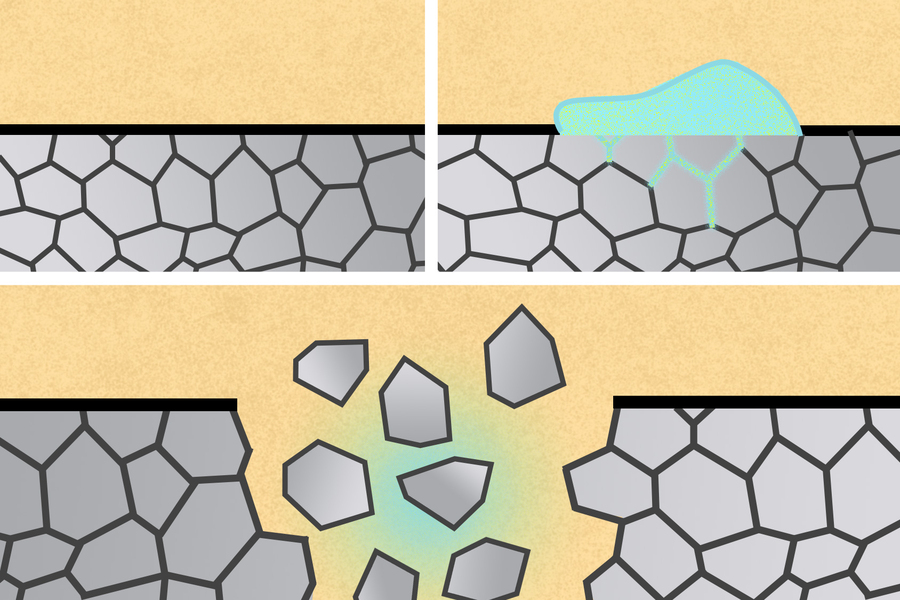创新背景
特拉弗索的实验室多年来一直在研究可以在消化道停留数天或数周的可消化设备,并按特定的时间表释放药物。
这些设备大多是由聚合物制成的,但最近研究人员一直在探索使用金属的可能性,金属更坚固、更耐用。然而,运送金属设备的挑战之一是找到一种方法,在它们不再需要时将其移除。
创新过程
麻省理工学院的研究人员利用一种导致金属断裂的现象,设计了一种更简单的移除不再需要的医疗设备的方法。
研究人员表明,用铝制成的生物医学设备可以通过将它们暴露在一种被称为共晶镓-铟(EGaIn)的液态金属中分解。在实践中,研究人员通过将液体涂在设备上,或者通过给患者注射EGaIn微粒来实现。
为了创造可以在体内按需分解的设备,研究团队从一种被称为液态金属脆化的现象中获得了灵感。这一过程已被充分研究为金属结构失效的来源,包括那些由锌和不锈钢制成的结构。

由铝制成的医疗设备可以通过将它们暴露于镓-铟中在体内分解,镓-铟是一种渗入金属颗粒之间边界的液态金属。
液态金属的某些组合实际上可以进入固体金属的晶界,导致它们急剧减弱并失效。一种能引起脆化的液态金属是镓。在这项研究中,研究人员使用了共晶镓-铟,这是一种镓的合金,科学家已经探索了在生物医学、能源和柔性电子领域的各种应用。
对于设备本身,研究人员选择了铝,因为铝在接触镓时很容易脆化。镓通过两种方式削弱铝等固体金属。首先,它可以扩散穿过金属的晶界——构成金属的晶体之间的晶界线——导致金属碎片断裂。麻省理工学院的研究小组表明,他们可以通过设计具有不同类型晶粒结构的金属来控制这种现象,允许金属破裂成小块或在给定点断裂。镓还能阻止铝在其表面形成一层保护性的氧化层,而氧化层会增加铝在水中的暴露程度,并促进其降解。
研究小组表明,在他们将镓-铟涂在铝装置上后,这些金属会在几分钟内分解。研究人员还创造了镓-铟的纳米粒子和微粒,并表明这些悬浮在液体中的粒子也可以分解铝结构。
研究人员最初想法是为了创造可以在胃肠道内分解的设备,但随着研究的发展,他们发现这也可以应用于其他生物医学设备,如钉针和支架。
为了演示在胃肠道中的应用,研究人员设计了一个星形装置,手臂通过空心铝管连接到中心弹性体上。药物可以在手臂中携带,该装置的形状有助于药物在胃肠道中保留较长一段时间。在一项动物研究中,研究人员表明,这种装置可以在用镓-铟处理后在胃肠道中分解。

医疗器械原型照片。
研究人员随后创造了铝钉,并证明它们可以用来将组织固定在一起,然后被镓-铟涂层溶解。
目前,食道支架要么永久留在体内,要么在不再需要时通过内窥镜取出。这种支架通常由镍钛合金等金属制成。研究人员现在正在研究是否可以用镍钛合金和其他金属制造出可溶解的装置。
在这项研究中,研究人员对啮齿动物进行了初步的毒性研究,发现镓-铟即使在高剂量下也是无毒的。然而,研究人员说,还需要更多的研究来确保它对患者的安全性。
创新关键点
在这项研究中,研究人员使用了共晶镓-铟,这是一种镓的合金;对于设备本身,研究人员选择了铝,因为铝在接触镓时很容易脆化。研究小组表明,在他们将镓-铟涂在铝装置上后,这些金属会在几分钟内分解。
创新价值
使用这种新方式触发这些装置的解体可以消除手术或内窥镜手术来移除它们的需要,这种方式更简单,且减少了对患者的损伤。
Innovative medical devices made of aluminum that break down in liquid metal
Using a phenomenon that causes metal to break, MIT researchers have devised an easier way to remove medical equipment that is no longer needed.
Researchers have shown that biomedical devices made from aluminum can break down by exposing them to a liquid metal called eutectic gallium-indium (EGaIn). In practice, researchers do this by applying liquid to the device, or by injecting patients with EGaIn particles.
To create devices that can break down in the body on demand, the research team took inspiration from a phenomenon known as liquid metal embrittlement. This process has been well studied as a source of failure in metal structures, including those made of zinc and stainless steel.
Certain combinations of liquid metals can actually enter the grain boundaries of solid metals, causing them to weaken dramatically and fail. One liquid metal that can cause embrittlement is gallium. For the study, the researchers used eutectic gallium-indium, an alloy of gallium that scientists have explored for a variety of applications in biomedical, energy and flexible electronics.
For the device itself, the researchers chose aluminum, which is prone to embrittlement when exposed to gallium.Gallium weakens solid metals like aluminum in two ways. First, it can spread through the grain boundaries of the metal -- the lines between the crystals that make up the metal -- causing the metal fragments to break. The MIT team showed that they could control this phenomenon by designing metals with different types of grain structure, allowing the metal to break into small pieces or break at a given point.Gallium also prevents aluminum from forming a protective oxide layer on its surface, which increases its exposure to water and promotes its degradation.
The team showed that after they applied gallium-indium to the aluminum device, the metals broke down within minutes. The researchers also created nanoparticles and particles of gallium-indium, and showed that these particles suspended in a liquid can also break down aluminum structures.
The researchers originally had the idea to create devices that could be broken down in the gastrointestinal tract, but as the research progressed, they found that this could also be applied to other biomedical devices, such as staples and stents.
To demonstrate its use in the gastrointestinal tract, the researchers designed a star-shaped device in which the arm is connected to a central elastomer via a hollow aluminum tube. The medication can be carried in the arm, and the shape of the device helps the medication remain in the gastrointestinal tract for a longer period of time. In an animal study, the researchers showed that the device could break down in the gastrointestinal tract after being treated with gallium-indium.
The researchers then created aluminum nails and demonstrated that they could be used to hold tissues together before being dissolved by a gallium-indium coating.
Currently, esophageal stents are either left in the body permanently or removed through an endoscope when they are no longer needed. The stent is usually made of a metal such as Nitinol. Researchers are now investigating whether dissolvable devices can be made from Nitinol and other metals.
In the study, the researchers conducted preliminary toxicity studies on rodents and found that gallium-indium is non-toxic even at high doses. However, more studies are needed to ensure its safety for patients, the researchers said.
智能推荐
生物医学创新 | 创新利用“双轴法”增加OCT在生物组织中的视野深度
2022-09-28杜克大学的生物医学工程师展示了一种增加光学相干断层扫描(OCT)对皮肤下结构成像的深度的新方法——双轴法。
涉及学科涉及领域研究方向细胞学创新 | 应用新型全息系统可捕捉到细胞的高速运动并进行成像
2022-09-28杜克大学的生物医学工程师设计了一种全息系统,该系统能够每分钟成像和分析数以万计的细胞,从而发现并识别疾病的迹象。
涉及学科涉及领域研究方向生物医学工程创新 | 将抗生素涂层创新应用于骨科植入物可降低感染机会
2022-09-28杜克大学的生物医学工程师等人发明了一种抗生素涂层,可以在手术前几分钟涂在骨科植入物上,从而消除植入物周围感染的机会。
涉及学科涉及领域研究方向医学成像技术创新 | 新型诊断成像技术可将切割精度提高10倍
2022-10-11加州理工学院的研究人员开发的一种新的诊断成像技术使外科医生能够将切割精度提高10倍,使他们能够保留多达1000倍的健康组织,并使患者更容易康复。
涉及学科涉及领域研究方向